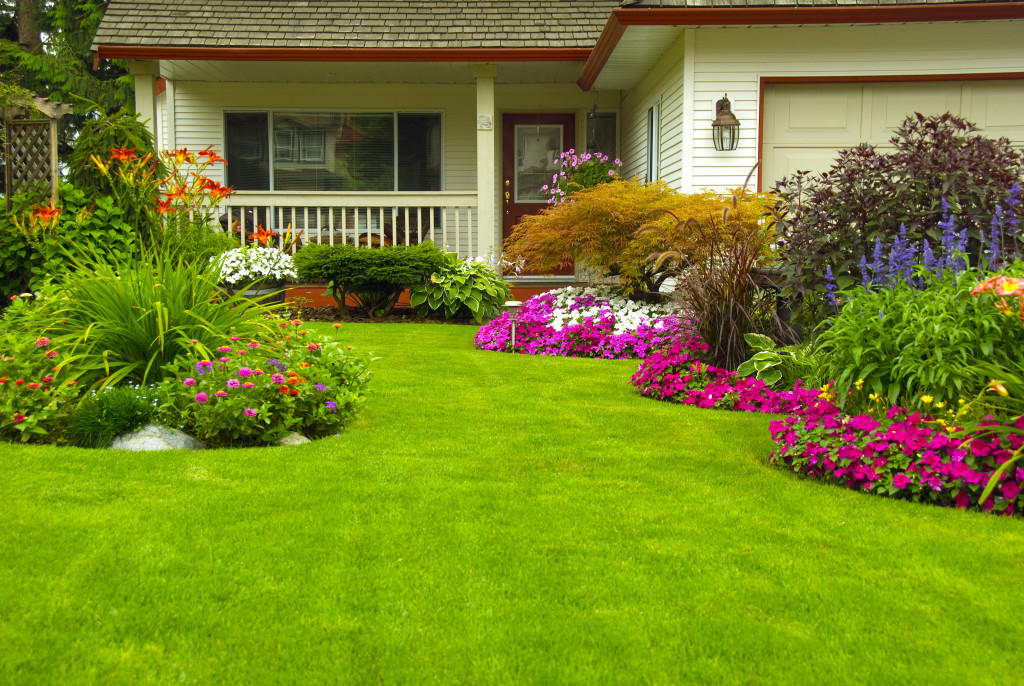- Get a soil test and aerate the soil to improve drainage and oxygenation and facilitate environmental protection.
- Prune, water, and fertilize trees to maintain their health.
- Water the lawn in the morning and avoid evaporation times.
- Plant wisely by choosing plants that match your climate and soil type.
- Invest in proper maintenance to keep your property looking beautiful.
Turfgrass is critical in urban and rural yards, parks, and lawns. Not only does it help to prevent erosion from water or wind, but it also aids in flood control by breaking down organic chemicals. Plus, turfgrass helps reduce noise levels while creating an inviting space for wildlife habitats and offering a cooling effect during the warmer months with its lush visual appeal.
For homeowners, having a lush and beautiful lawn is a source of pride. While some may think that having a great lawn involves luck or expensive landscaping, there are many things you can do to enhance your lawn, even on a budget. Here are some tips to help you create the perfect lawn.

Start with a Soil Test
Before planting grass or flowers, take the time to have your soil tested. This will tell you what nutrients are lacking in the soil so that you know exactly what type of fertilizer and other treatments need to be applied. Also, consider getting your soil aerated to improve drainage and oxygenation.
Environmental Protection
Testing your soil is the key to helping you save money, conserve energy and protect your environment. Test results can identify soils contaminated with heavy metals like lead or help bolster a nutrient-poor soil’s nutritional balance. Beyond this, testing also helps diagnose and solve plant culture problems quickly and efficiently, ensuring your garden will be beautiful for years!
Take Care of the Trees
Taking care of the trees on the lawn is an essential aspect of residential landscaping. Trees provide beauty, shade, and protection from the sun and wind. They also play a vital role in the environment by filtering air pollution, providing habitat for wildlife, and storing carbon dioxide. Properly caring for trees is essential to preserving their health and longevity.
Pruning the Tree
Regular pruning, watering, and fertilizing are all important steps in keeping trees healthy. As trees grow, they require additional pruning to maintain their shape and size. Removing dead or diseased branches is also necessary for the tree’s health. If you plan to prune the trees yourself, you should observe all the safety measures to avoid accidents.
You should look for durable arborist ropes to ensure you do not fall when you work on the trees. These ropes are designed to help you ascend and descend from a tree. They have a bit of stretch to absorb kinetic energy when climbing the tree. You can contact a reliable outside sales agent of a reputable company to help you find one. The agent should offer several options that are suitable for your needs.
Watering and Fertilizing the Trees
Watering is also essential; depending on weather conditions, some trees may need to be watered more frequently than others. Fertilizing is also important, as it helps trees absorb nutrients from the soil and grow strong and healthy.

Know When to Water
Make sure that you’re watering your lawn at the right times of the day. Watering in the morning is best because it gives your plants time to absorb water before it evaporates from the sun’s heat later in the day.
High Evaporation Rates
Additionally, avoid watering when evaporation rates are high, such as between 10 am and 2 pm. Use an irrigation system to ensure your plants get enough water without over-watering them, if possible. Watering in the evening isn’t recommended because wet leaves can attract pests and diseases.
Check the Weather Forecast
Finally, check the forecast before you water your lawn. If rain is expected, it’s best to hold off on watering until after the storm passes. This will save you time, money, and energy. Additionally, if there’s been a recent rainfall, check your soil before you water. If the top two or three inches of soil are moist, you don’t need to add more water immediately. Doing so could lead to overwatering, damaging your lawn and plants.
Plant Wisely
When selecting plants for your lawn, choose those that match your climate and soil type as closely as possible. These plants will require less maintenance and be more likely to thrive with minimal effort from you! For example, if you live in an area with hot temperatures, look for drought-tolerant plants such as cacti or succulents instead of flowers that require lots of water.
With these tips for creating the perfect lawn, homeowners can create a lush and beautiful outdoor space without breaking their budget! Properly taking care of one’s property will go a long way toward making their home look inviting for years to come! Taking care of one’s property properly is one of those investments worth making. After all, there’s no better feeling than coming home each day knowing it looks its best!

